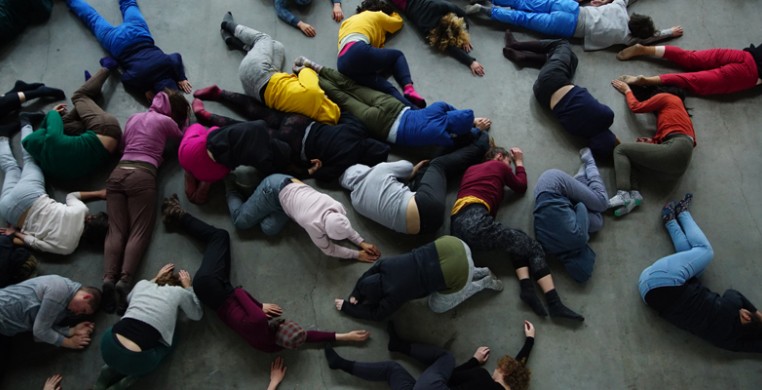It started slow, with a small group of people sitting clumped on the steps outside the Museum of Contemporary Art Chicago (MCA). So subtle that it was barely recognizable as the performance. Then, as seemingly normal museum visitors trickled into the group, the clump formalized, dancers slouching on top of each other and the stairs, slightly shifting and changing position. This series of shifts gradually brought the dancers up the stairs to standing shifts, and the dancers maintained slouched shoulders, collapsed waists and blank expressions as they shuffled in pairs through the revolving doors into the MCA.
30 minutes into Kim Brandt’s “Level,” which premiered at the MCA Oct 1, I wondered, “Are they going to continue shuffling in this group for the rest of the piece?” And sure enough, they never stopped this moving cluster, with dancers making improvised choices to move further into or around the clump, varying only in level (how slouched or folded they were towards the floor), who (if anyone) they were slouched against, and placement in the museum.
But even though Brandt’s choreography sits onlookers through an hour of practically the same movement repeated (with variation), the audience never lacked something to focus on or contemplate. Paired with ambient music performed by a group of live musicians, the consistent motion provided the constant variable necessary to understand the multiple other elements in the space that changed throughout the piece.
In such an intimate space—with no formal seating outside the couple of benches strewn about the lobby—the audience was gifted with agency to decide how they wanted to experience the piece. Some watched from afar, standing in one spot against the walls for the entirety of the work. Some moved about the space to view the moving clump from different angles, often so close to the dancers as they passed by that they seemed to join the piece for a moment, shifting forward in space along with the slouched travelers until they resumed their role as formal audience members on the other side of the room. Some audience members became engulfed in the group for a few moments, forced to respond either by confronting the dancers head-on, or looking or moving away.
The dancers disappeared one by one around the corner leading into the MCA Commons, and I was so engulfed in how the other onlookers were responding to the group that I was surprised when dancers reappeared in a second floor room directly above the Commons, flanked by glass walls. For a few moments, the audience was suspended in a blend of two-dimensionality and three-dimensionality before the rest of the group made its way to the second floor and the viewers were physically separated from the performers.
It was in those suspended moments that Brandt’s exploration of bodies in space rang clear. On one floor, an image of how human beings interact in public spaces: aware of each other, maybe even reliant on or comforted by the presence of others, while remaining emotionally guarded. On the other floor, movement inside a box and out of reach, prodding the audience to contemplate how we experience art (or any other sensation) when intimacy is taken away and we aren’t able to physically connect with it.
“Level” took the traditional museum and performance experience and flipped them around and inside out. Through the use of an almost scientific movement pattern where the audience is as integral to the outcome of the performance as the dancers, Brandt prompted the audience to actively engage with the art in their lives—and to engage in a work where meaning shifts based on the choices viewers make.
--
“Level” continues Oct. 2 and 3, 12:30 p.m., at the Museum of Contemporary Art Chicago, 220 E. Chicago Ave. Tickets are free with admission to the museum. For more information, click the event link below.


